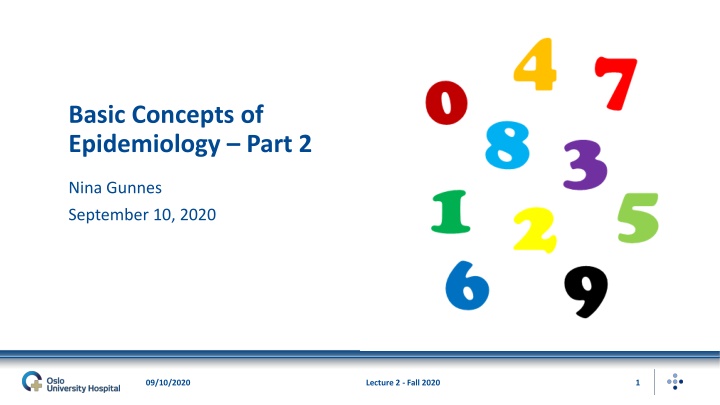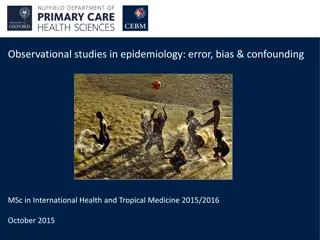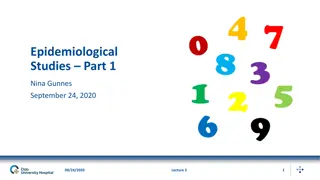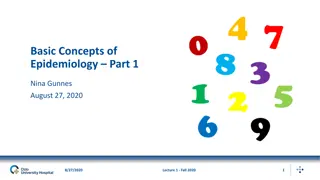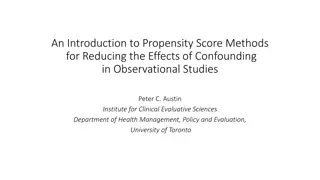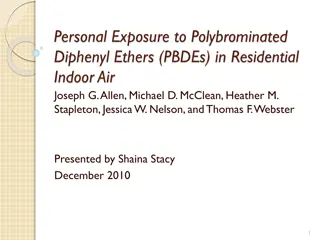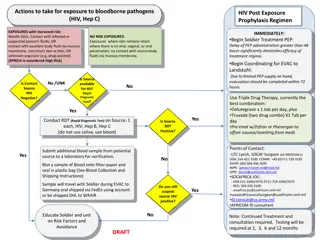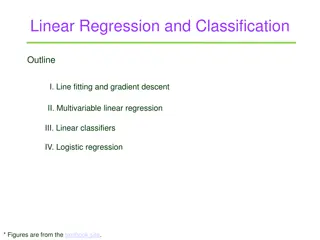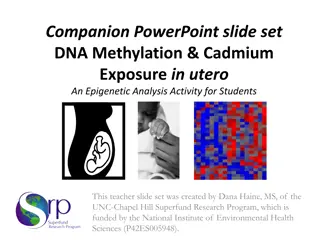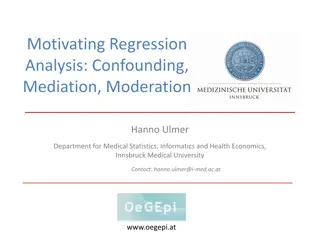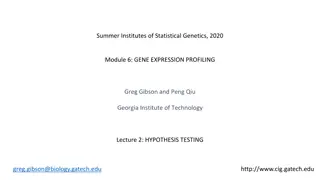Basic Concepts of Epidemiology: Exposure, Confounding, and Multivariable Methods
Epidemiology explores how variables like smoking, overweight, and physical activity affect disease risk. Confounding factors, like smoking impacting the link between diet and lung cancer, must be considered to avoid biased results. Techniques such as adjustment, stratification, and multivariable statistical methods (e.g., regression) help analyze complex relationships and account for multiple variables in epidemiological studies.
Download Presentation

Please find below an Image/Link to download the presentation.
The content on the website is provided AS IS for your information and personal use only. It may not be sold, licensed, or shared on other websites without obtaining consent from the author.If you encounter any issues during the download, it is possible that the publisher has removed the file from their server.
You are allowed to download the files provided on this website for personal or commercial use, subject to the condition that they are used lawfully. All files are the property of their respective owners.
The content on the website is provided AS IS for your information and personal use only. It may not be sold, licensed, or shared on other websites without obtaining consent from the author.
E N D
Presentation Transcript
Basic Concepts of Epidemiology Part 2 Nina Gunnes September 10, 2020 09/10/2020 Lecture 2 - Fall 2020 1
Exposure Variable that can cause or prevent disease (or other health outcomes) Smoking: increasing risk of lung cancer and cardiovascular disease Overweight: increasing risk of cardiovascular disease Physical activity: reducing risk of colon cancer and cardiovascular disease Age, sex, education, place of residence, genes, etc. Also known as risk factor Leading to disease by increasing the risk Protecting against disease by reducing the risk 09/10/2020 Lecture 2 - Fall 2020 2
Confounder Also known as a confounding variable Common cause of the exposure and the outcome Could confounding have influenced the study findings? People rarely exposed to one risk factor alone Association between diet and lung cancer confounded by smoking Usually a stronger association when smoking is not taken into account Diet potentially differing between smokers and non-smokers Smoking increasing the risk of lung cancer 09/10/2020 Lecture 2 - Fall 2020 3
Confounder, cont. Smoking (confounder) Diet Lung cancer (outcome) (exposure) 09/10/2020 Lecture 2 - Fall 2020 4
Confounder, cont. Must always consider confounding Confounding not taken into account giving rise to erroneous results Too strong or too weak associations Spurious associations Undetected associations Age being a common confounder in epidemiological studies Age-standardized incidence rates in population statistics Taken into account when estimating exposure-outcome association 09/10/2020 Lecture 2 - Fall 2020 5
Confounder, cont. Take ? into account in the analysis Adjustment Stratification Standardization ? ? ? 09/10/2020 Lecture 2 - Fall 2020 6
Multivariable statistical methods Also known as multiple statistical methods Involving multiple independent variables (predictors) Exposures, confounders, etc. Method depending on study design and types of variables included Multiple linear regression Multiple logistic regression Multiple Cox regression Multiple Poisson regression 09/10/2020 Lecture 2 - Fall 2020 7
Example 10.4 in Aalen et al. (2006) Folate supplementation and twin pregnancies (Vollset et al., 2005) Data from the Medical Birth Registry of Norway Births from December 1998 through the end of 2001 Preconceptional use of folate and multivitamin supplements Folate use No folate Total Twin pregnancy 329 2,825 3,154 Singleton pregnancy 10,748 162,140 172,888 Total 11,077 164,965 176,042 09/10/2020 Lecture 2 - Fall 2020 8
Example 10.4 in Aalen et al. (2006), cont. Defining the odds of twin pregnancy in each folate group Folate use: ?1 1 ?1 = ?1 No folate: ?2 1 ?2 = ?2 Calculating the crude odds ratio of twin pregnancy for folate use OR = ?2 95% confidence interval (CI): 1.57 1.97 Spurious association? ?1 ?1 ?2 ?2 ?1 1 ?1 1 ?2= 329 10,748 2,825 162,140= 329 162,140 2,825 10,748= 1.76 09/10/2020 Lecture 2 - Fall 2020 9
Example 10.4 in Aalen et al. (2006), cont. 1.5% of pregnancies resulting from in vitro fertilization (IVF) Higher proportion of twin pregnancies after IVF Natural conception: 1.4% IVF: 27% Use of folate 4 times as frequent among women conceived by IVF Natural conception: 6.0% IVF: 24% Confounding by IVF? 09/10/2020 Lecture 2 - Fall 2020 10
Example 10.4 in Aalen et al. (2006), cont. IVF IVF IVF Folate use Twinning Maternal age Maternal age Maternal age Parity Parity Parity 09/10/2020 Lecture 2 - Fall 2020 11
Example 10.4 in Aalen et al. (2006), cont. Adjusting for potential confounders using logistic regression Maternal age and parity: OR = 1.59 (95% CI: 1.41 1.78) Maternal age, parity, and IVF: OR = 1.04 (95% CI: 0.91 1.18) No evidence of association between folate use and twinning Association strongly confounded by IVF 09/10/2020 Lecture 2 - Fall 2020 12
Collider Common effect of exposure and outcome Do not take ? into account in the analysis May cause selection bias ? ? ? 09/10/2020 Lecture 2 - Fall 2020 13
Collider, cont. 09/10/2020 Lecture 2 - Fall 2020 14
Collider, cont. Hypothetical example by Cole et al. (2010) 100 persons attending a meeting 10 persons pre-symptomatically infected with influenza upon arrival Ignoring transmission of influenza between people 50 chicken and 50 (tainted) egg-salad sandwiches randomly assigned No association between preexisting influenza and sandwich type 55 persons developing fever that evening Fever either due to influenza or egg-salad sandwich or both Fever a common effect of influenza and sandwich type 09/10/2020 Lecture 2 - Fall 2020 15
Collider, cont. Influenza Sandwich type Fever Based on Figure 1 in Cole et al. (2010) 09/10/2020 Lecture 2 - Fall 2020 16
Collider, cont. Influenza Yes No Total Risk Risk difference Unconditioned Chicken sandwich 5 45 50 0.1 0.0 Egg-salad sandwich 5 45 50 0.1 Conditioned Fever Chicken sandwich 5 0 5 1.0 0.9 Egg-salad sandwich 5 45 50 0.1 No fever Chicken sandwich 0 45 45 0.0 NA Egg-salad sandwich 0 0 0 NA Based on Table 1 in Cole et al. (2010) 09/10/2020 Lecture 2 - Fall 2020 17
Mediator On the causal pathway between the exposure and the outcome Direct effect of ? on ? Take ? into account in the analysis Total effect of ? on ? Do not take ? into account in the analysis ? Indirect causal path Direct causal path ? ? 09/10/2020 Lecture 2 - Fall 2020 18
References Aalen OO, Frigessi A, Moger TA, Scheel I, Skovlund E, Veier d MB. 2006. Statistiske metoder i medisin og helsefag. Oslo: Gyldendal akademisk. Cole SR, Platt RW, Schisterman EF, Chu H, Westreich D, Richardson D, Poole C. Illustrating bias due to conditioning on a collider. Int J Epidemiol. 2010 Apr;39(2):417-20. doi: 10.1093/ije/dyp334. Epub 2009 Nov 19. PMID: 19926667; PMCID: PMC2846442. Stian Lydersen. Effect Modification and Mediation. October 6, 2017. Updated September 8, 2020. http://folk.ntnu.no/slyderse/medstat/Effectmod_mediation_6Oct2017.pdf. Accessed September 9, 2020. Vollset SE, Gjessing HK, Tandberg A, et al. Folate supplementation and twin pregnancies. Epidemiology. 2005;16(2):201-205. doi:10.1097/01.ede.0000152914.84962.13. Zarghooni S. Sjokolade og fotball som medierende variabler i et kj rlighetsforhold. L relogg: Masterstudier i arbeids- og organisasjonspsykologi. 2010. https://zarghooni.wordpress.com/2010/12/26/sjokolade-og-fotball-som-medierende-variabler-i- et-kjaerlighetsforhold/. Accessed September 9, 2020. 09/10/2020 Lecture 2 - Fall 2020 19
